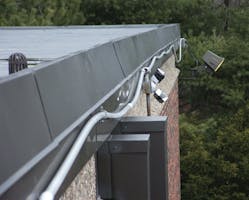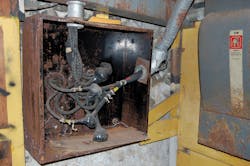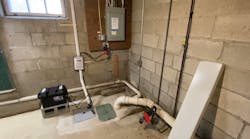All references are based on the 2017 edition of the NEC.
A Droopy Disaster
This is not a flexible cord you’re looking at. A closer look reveals this PVC conduit has bowed and flexed so much that it seems to look like flexible cord. How can this happen? Unfortunately, I seem to have a ton of photos of failed PVC conduit installations, which means the word is still not getting out that one of the most important components of a PVC conduit installation is the use of expansion fittings, which are designed to help minimize this exact problem from happening.
As outlined in Sec. 352.44, expansion fittings are needed for PVC conduit when the length change in a straight run of the conduit is expected to be ¼ in. or more between securely mounted boxes, cabinets, elbows, or other conduit terminations. Table 352.44 explains the expansion characteristics of PVC conduit. For an outdoor installation, the PVC conduit could easily be exposed to temperature changes approaching 100°F from the hottest summer day to the coldest winter day. This wide swing in temperatures would cause a 100-ft run of conduit to have a length change of approximately 4 in.! That is amazing. If an expansion fitting is not provided, the result will look like the installation in my photo.
A Junky Junction Box
I spotted this mess in the basement of a local business. It’s a junction box for the underground service conductors. The lack of a cover was what caught my attention. The missing box cover violates Sec. 314.25.
Because the cover was missing, I decided to get a closer look and noticed there were no bonding bushings or grounding locknuts installed on any of the service raceways. This lack of proper raceway bonding and grounding is a violation of Sec. 250.92(A) and (B). I also observed that the junction box was not bonded to the grounded conductor either. This is another violation of the rules in Sec. 250.92.
Further examination revealed that flexible metal conduit (FMC) was used for enclosing one set of the service entrance conductors. Section 230.43(15) does permit the use of FMC for wiring of services of 1,000V or less, with some limitations. The FMC must be no longer than 6 ft between raceways — or between a raceway and service equipment. This FMC was close to 20 ft long. A supply side bonding jumper (SSBJ) must also be routed with the FMC. Although this FMC does have an SSBJ, it’s improperly connected to the clamping screws on the outside of the FMC connector instead of being bonded to the grounded conductor.






